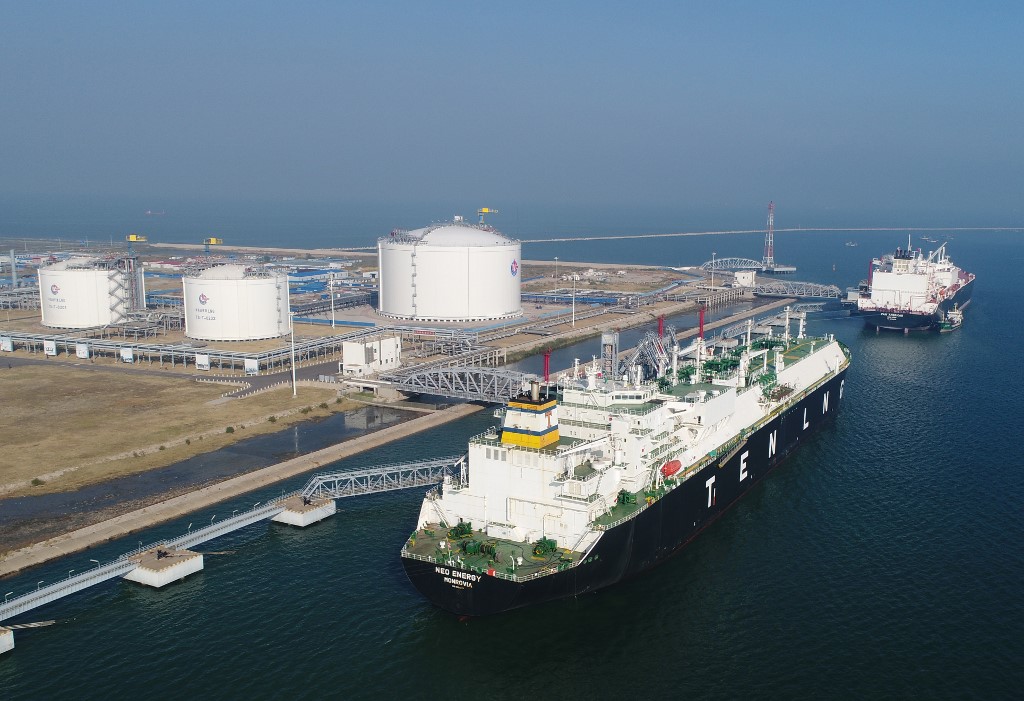(ATF) Australia, the world’s largest liquefied natural gas (LNG) exporter, with a liquefaction capacity of 80 million tonnes per annum (mtpa), has shaken off Covid-19 doldrums as its exports of the super-cooled fuel reached a monthly record in March.
Part of that uptick came from several Aussie projects increasing production but also from more Chinese procurement of the fuel, data from consultancy EnergyQuest shows.
Chinese firms bought some eight Australian LNG cargoes in the month, helping Aussie LNG producers lock in more profit amid year-on-year price increases for the fuel.
Aussie LNG imports from South Korea and Taiwan also set monthly records, while imports from India and Malaysia also ticked upward.
India, for its part, is in the midst of a government-driven push to increase natural gas as part of its energy mix from a current 6.2% to as much as 15% by 2030, to help the Modi government pivot to what it called last year a “natural gas-based economy.”
Total Aussie LNG exports on the month increased around 20% over February levels to some 7.2 million tonnes, and some 100,000 tonnes higher than the previous record set in December 2019.
Japan is the world’s largest LNG importer, followed by China, South Korea, India and Taiwan, while the entire Asia-Pacific region accounts for around two-thirds of total global LNG demand.
That demand is projected to increase even more by mid-decade amid new consumption in South Asia, namely Pakistan, Sri Lanka and Bangladesh and in Southeast Asia from the Philippines, Vietnam and Thailand as well as others.
Strained Sino-Australian relations
China’s ramped-up Aussie LNG procurement comes as the two nations are still squaring off over a number of issues, ranging from Canberra’s insistence last year that the world investigate China as the origin of the coronavirus, incensing Beijing over its implication.
Beijing fired back in a strategic trade retaliatory move, targeting several Australian industries, including coal, barley and wine, plus many other sectors.
The two governments are also increasingly on opposite sides of South China Sea tensions as Beijing presses its hard to prove historical ownership of around 90% of the integral waterway, forcing Canberra into even greater reliance on long-time ally the US as a counterweight.
For now, ongoing Sino-Australian political problems haven’t hit Australia’s LNG exports to China and given the symbiotic relationship between Aussie gas and China’s thirst for the fuel, that dynamic may not materialize.
However, it’s often hard to figure out Beijing’s energy geopolitical playbook on a good day, but since the three-year trade war between Washington and Beijing and now during the Covid-19 era, that task has proven even more difficult.
China, for its part, does have a plethora of natural gas supply options to draw from, including increased gas pipeline imports from neighboring Russia and several other LNG producers. As such, Australia’s future LNG exports to China are anything but guaranteed.
Going forward, several long-term LNG off-take agreements between the two sides are expected to expire amid the ongoing trade and political row. To make up for these expiring contracts, Chinese firms will likely continue to buy more LNG on the spot market at advantageous contractual terms and prices, as well as inking new mid to long-term deals with a number of other LNG producers eager to lock-in market share with the world’s largest energy and gas consumer.
China’s imports of US LNG, for its part, have also been increasing though there remains a 10% retaliatory tariff on the fuel, lowered from a previous 30% as part of the so-called phase one trade deal reached in January 2020 between then US President Donald Trump and China.
The centrepiece of the agreement is China’s commitment to buy at least $200 billion more in US goods and services over two years (2020 and 2021), above 2017 baseline levels, including $52.4 billion worth of US energy goods based on market prices and commercial considerations. But no specified sum for LNG or crude was mentioned in the phase one deal.
However, in 2020, China’s total imports of covered products reached only 58% of the commitment, according to data from the Peterson Institute for International Economics (PIIE).
























